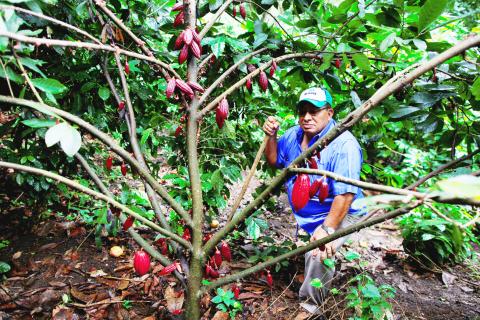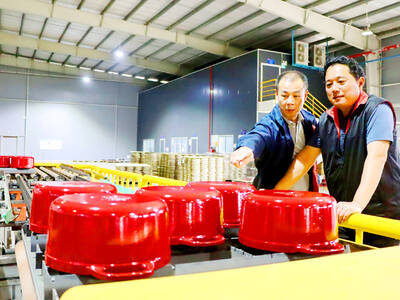Farmer Abelardo Ayala took a tough decision on his estate in San Juan Tepezontes, a traditional coffee-producing region of El Salvador: to swap his coffee trees for cocoa as a warming climate hit his crop.
Ayala said his plantation — situated between 600m and 1,000m above sea level in the south-central department of La Paz — had been ideal for growing coffee. However, with rising temperatures, production became difficult.
In the past four years, recurring drought, a plague of coffee borer beetles and other problems linked to climate shifts put his coffee plantation on the ropes.

Photo: Reuters
The farmer tried sowing varieties resistant to a widespread fungus called roya (coffee rust), which affects the leaves and harms bean production, but that failed to protect his harvest.
In low-lying areas, many producers have abandoned their crops, or sold their land to urban developers.
However, Ayala started to study the benefits of cocoa, including its low cost of production, good price on international markets and environmental value, such as protecting water basins and wildlife.

Photo: Reuters
“People here are starting to cultivate cocoa in zones where before there was coffee,” the farmer told the Thomson Reuters Foundation. “Drought and climate change are making it impossible to work with coffee, so we produce cocoa now.”
Mexico and Central America, which together produce one-fifth of the world’s Arabica coffee beans, have been hit hard by roya and the volatility of coffee prices in the last few years.
“The situation has led many producers to change from coffee to cocoa. It is happening step by step,” Nicaraguan farmer Luis Moreno said, referring to growers in Jinotega department, one of the nation’s principal coffee regions.
“Where they have coffee, they get a harvest and then take out [the plant] — so now they are left only with cocoa cultivation,” he said.
Moreno is technical coordinator for the People’s Community Action Association, which has been giving cocoa plants and technical help to small producers since 2014. He says the program has been a success so far.
The farmers find it cheaper to grow cocoa because it needs fewer workers and about 40 percent less investment in inputs than coffee, while international prices are buoyant.
“It is more profitable,” Moreno said.
According to VECO, a Belgium-based non-governmental organization that works with small-scale farmers in developing countries, Central America has about 25,000 cocoa producers, spread across Guatemala, Honduras, Nicaragua and El Salvador, growing cocoa on about 12,700 hectares.
VECO estimates cocoa production will expand to about 25,500 hectares in 2019.
“Many studies prove that coffee production will move higher up because of global warming,” VECO regional director Karen Janssens said. “For this reason, cocoa could be an alternative for producers whose estates are in lower zones.”
When the Spanish arrived in Mesoamerica in the early 1500s, they observed that indigenous people used cocoa seeds like currency.
Cocoa is a species native to the region and was cultivated by the Aztec, Mayan and Pipil people until the 19th century when coffee was introduced from Africa, largely replacing cocoa.
Salvadoran National Indigenous Coordinating Council member Nestor Perez said indigenous communities began re-introducing cocoa trees on their lands in 2014.
“We can see [this trend] not only from an economic or environmental point of view, but we can also link it with our cultural identity, because our people grew cocoa traditionally,” Perez said.
Indigenous peoples use cocoa to make chocolate, or in ceremonies where they burn cocoa seeds and chocolate in a wood fire to express gratitude to “Mother Earth” for the harvest.
However, while cocoa production may be better suited to low altitudes in a warmer world, the writing is not yet on the wall for coffee. Experts predict farmers will continue to produce coffee in mountainous areas, or adapt the way they cultivate it as the climate changes.
Some coffee producers are making an effort to revive their crop.
Francisco Flores Recinos, for example, has started planting cocoa and other fruit trees among his coffee plants to diversify production on his estate in Jayaque in central El Salvador.
Flores Recinos is growing about 4 hectares of cocoa interspersed with coffee as part of a project supported by the Salvadoran Ministry of Agriculture, which is helping more than 300 farmers cope with climate shifts.
“I thought of mixing cocoa and coffee in some areas of my estate where there was water nearby, before roya attacked,” the producer said.
If his coffee trees do suffer from roya, the profit from his cocoa crop will help cushion any losses, he added.

TAKING STOCK: A Taiwanese cookware firm in Vietnam urged customers to assess inventory or place orders early so shipments can reach the US while tariffs are paused Taiwanese businesses in Vietnam are exploring alternatives after the White House imposed a 46 percent import duty on Vietnamese goods, following US President Donald Trump’s announcement of “reciprocal” tariffs on the US’ trading partners. Lo Shih-liang (羅世良), chairman of Brico Industry Co (裕茂工業), a Taiwanese company that manufactures cast iron cookware and stove components in Vietnam, said that more than 40 percent of his business was tied to the US market, describing the constant US policy shifts as an emotional roller coaster. “I work during the day and stay up all night watching the news. I’ve been following US news until 3am

Six years ago, LVMH’s billionaire CEO Bernard Arnault and US President Donald Trump cut the blue ribbon on a factory in rural Texas that would make designer handbags for Louis Vuitton, one of the world’s best-known luxury brands. However, since the high-profile opening, the factory has faced a host of problems limiting production, 11 former Louis Vuitton employees said. The site has consistently ranked among the worst-performing for Louis Vuitton globally, “significantly” underperforming other facilities, said three former Louis Vuitton workers and a senior industry source, who cited internal rankings shared with staff. The plant’s problems — which have not

TARIFF CONCERNS: The chipmaker cited global uncertainty from US tariffs and a weakening economic outlook, but said its Singapore expansion remains on track Vanguard International Semiconductor Corp (世界先進), a foundry service provider specializing in producing power management and display driver chips, yesterday withdrew its full-year revenue projection of moderate growth for this year, as escalating US tariff tensions raised uncertainty and concern about a potential economic recession. The Hsinchu-based chipmaker in February said revenues this year would grow mildly from last year based on improving supply chain inventory levels and market demand. At the time, it also anticipated gradual quarter revenue growth. However, the US’ sweeping tariff policy has upended the industry’s supply chains and weakened economic prospects for the world economy, it said. “Now

COLLABORATION: Given Taiwan’s key position in global supply chains, the US firm is discussing strategies with local partners and clients to deal with global uncertainties Advanced Micro Devices Inc (AMD) yesterday said it is meeting with local ecosystem partners, including Taiwan Semiconductor Manufacturing Co (TSMC, 台積電), to discuss strategies, including long-term manufacturing, to navigate uncertainties such as US tariffs, as Taiwan occupies an important position in global supply chains. AMD chief executive officer Lisa Su (蘇姿丰) told reporters that Taiwan is an important part of the chip designer’s ecosystem and she is discussing with partners and customers in Taiwan to forge strong collaborations on different areas during this critical period. AMD has just become the first artificial-intelligence (AI) server chip customer of TSMC to utilize its advanced